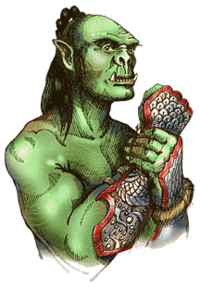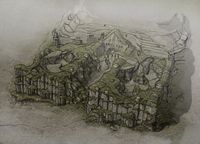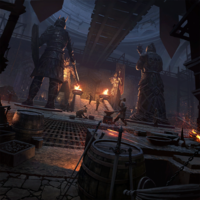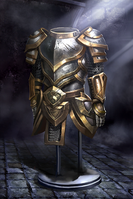Lore:Orsinium
| Orsinium | |
|---|---|
| Type | Region |
| Continent | Tamriel |
| Appears in | Daggerfall, ESO |
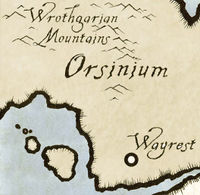
Orsinium (which literally translates to "Orc-Town" in Aldmeris,[1] also called the City of Orcs)[2] is the city of the Orsimer and the provincial seat of the region of Wrothgar, which came to be known as the Orsinium Area in the late Third Era. It has been sacked and rebuilt many times over the centuries, as the Orcs are often at odds with their Breton and Redguard neighbors. Orsinium was first built in High Rock, straddling the boundary between western Wrothgar and Rivenspire. In the mid-Second Era, the city was relocated to eastern Wrothgar.[3] In 3E 399, it was relocated again to a site between Wayrest, Menevia, and the Wrothgarian Mountains.[4] By 4E 201, Orsinium had been moved a third time, farther south to an area between Hammerfell and Skyrim.[5] The royal palace of the city is traditionally known as Scarp Keep.[6]
The exact date of the first Orsinium's founding is unknown, but it is known to have grown powerful as early as the ninth century of the First Era.[7][8]
History[edit]
First Era[edit]
The First Orsinium[edit]
It is said after the transformation of the Orsimer deity known as Trinimac into the Daedric Prince Malacath, the Orcs, who transformed as well, fled to the northern wastes, near Saarthal.[9] During the First Era, after hundreds of Orcs, ogres, goblins, gremlins and other beastfolk were set free by the Altmer during the Camoran Dynasty, they chose to settle in an uninhabited mountain region close to Old Hroldan in High Rock, as their people were dependent on a rare, shaggy, giant centipede herd-beast that could only survive at high altitudes. This is where the first Orsinium was founded.[1]
The polity that would become the First Orsinium that the Orcs of later eras hoped to re-establish is usually dated to the tenth century of the First Era, when Chieftain Torug gro-Igron brought the Orcish people together and founded a village in the western Wrothgarian Mountains.[10] Though this dating is possibly incorrect, as there was known to be a powerful Orsinium as early as the ninth century,[7][8] and Torug is said to have died "long before" 1E 950,[11][12] The first Orsinium started not as a city but as an armed camp. Eventually, the camp grew into a village, and the village expanded into a town. In just a few short years, it became a sprawling, indefensible mass of people and buildings.[13] Thanks to the cooperation of several Orcish clans, particularly Igrun, Morkul, Shatul, and Tumnosh, the village quickly grew into a great stone city.[3]
The first Orsinium drew the Orcs by its magnificence and Torug's vision of a united Orc nation. They would eventually be joined by Orc clans from other regions, like those who were fleeing Hammerfell due to the Ra Gada invasion.[1] Warlord Thulgeg led a group of Orcs and Goblins from Hammerfell on an exodus to High Rock in 1E 874 after being driven out of the province by the Redguards, eventually leading them northeast through the Dragontail Mountains before they finally reached Orsinium,[8][14] where they helped to continue laying the foundations of the great city.[15]
The Siege of Orsinium[edit]
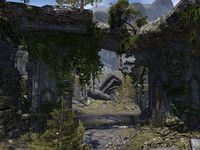
King Golkarr of the Orcs amassed an army and was determined to seize control of the Bjoulsae River,[16][1] upon which the nomadic Breton Bjoulsae River Tribes lived.[17] They intended to force Wayrest to pay to regularly use the river for travel and trade.[1] Naturally, this did not settle well with their neighboring kingdoms, especially the Kingdom of Daggerfall. In 1E 948, King Joile of Daggerfall sent a letter to Gaiden Shinji of the Order of Diagna, which proposed a joint attack on Orsinium. Agreeing to provide aid, an alliance was formed between the Order of Diagna, the armies of Daggerfall (High Rock), and Sentinel (Hammerfell). The Bjoulsae River Tribes also agreed to lend their aid.[18][19] The armies amassed and began a campaign for the destruction of Orsinium.[7][10] Two years later, in 1E 950 the siege began.[20][21] Guthrag Stone-Talker's diplomatic prowess was acknowledged as one of the factors in postponing the siege for more than a decade.[22]
During the 30-year campaign, which became widely known as the "Siege of Orsinium", the Breton armies of Daggerfall, the Redguard soldiers of Sentinel, and the Yokudan Order of Diagna invaded the Orc homeland. The Orcs gave much resistance and proved themselves to be fearsome and brutal warriors, just as they did in the past. However, King Joile of Daggerfall already planned to betray the Redguards and invade Hammerfell after having destroyed Orsinium. He and his Reachman general, Mercedene of the Winterborn, tricked the Orcish hero Baloth Bloodtusk and his Savage Sons, who initially did not take part in the war, to join King Golkarr of Orsinium. Afterwards, he manipulated the leader of the Order of Diagna, Gaiden Shinji, into having a duel with Bloodtusk over Orsinium's fate. During the duel, Mercedene ordered Joile's archers to kill both combatants, effectively removing the most powerful warriors of both Orsinium and the Order of Diagna for Joile.[3] In 1E 973, with Orsinium's defeat still years away, King Joile launched his invasion of Hammerfell, but he was defeated and killed at the Bangkorai Pass by the Ansei warrior Makela Leki.[23]
The Siege of Orsinium finally ended in 1E 980 when the allied forces breached the city's defenses, overran it, and razed it to the ground. Despite this loss, it did not mark the end of either the Orcs or the dream of Orsinium.[7][10] The city was rebuilt in the same location and razed again at least two more times over the following centuries.[24] Certain accounts suggest that the Redguard victory was attributed to the sacrifice of Armiger Rhina from the Order of Diagna.[25]
The Bretons experienced a period of economic expansion after they razed Orsinium, for the Bjoulsae River region was greatly opened up for trade. The kingdom of Evermore was founded by the Bjoulsae River Tribes,[19] and Wayrest also established a presence on both banks of the region. The Masconian Trade Way was formed by the hard-working traders and merchants of the Bjoulsae River. Not only did it bring about a decline in piracy, it also led to a great expansion of the Bjoulsae's trade and community.[7] One such factor that contributed to this was Daggerfall's ivory trade, which originated with ivory plundered from Orsinium following its sacking.[26]
The artifact Chrysamere was present in the first sacking of Orsinium.[27]
Several sources contradict the most commonly accepted date of the siege of the first Orsinium. The Direnni claim to have launched the first sacking of Orsinium by Ryain Direnni with the help of his Breton legions,[28] and he was a figure who was active around the fifth century of the First Era.[29] The epic known as Poison Song takes place around 1E 675, and has Gaiden Shinji and King Joile as participants in the siege but as an event that happened in the past.[30] At least one source has Gaiden Shinji's most famous quote dated to 1E 490.[5]
Second Era[edit]
From Imperial Recognition to Dispersal[edit]
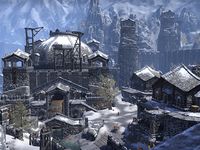
Orsinium was accepted as a province of the Second Empire during the reign of the Akaviri Potentate Savirien-Chorak.[1][3][31][32] During that brief period, Frostbreak Fortress was built to help defend it.[24] After the assassination of Savirien-Chorak in 2E 430, Orsinium lost its status and protection as an Imperial territory, resulting in another sacking of the city in 2E 431, an assault which was spearheaded by the Bretons of Shornhelm.[1][33]
Not content to simply destroy Orsinium this time, the Bretons also apparently seized control of the land and scattered the Orcs across northern Tamriel.[34][35] Some Orcs chose to retreat to their strongholds in northern Wrothgar, while others set out to reassert ancient territorial claims in Skyrim. Chief Yashnag gro-Yazgu in particular succeeded in carving out a chiefdom in western Falkreath that persisted until 2E 467, when Yashnag and his champions were slain by Hakkvild Yashnag-Slayer, the Jarl of Falkreath, in a ritual of single-combat.[35]
King Kurog's Orsinium[edit]
When King Ranser of Shornhelm attacked Wayrest in 2E 566, King Emeric of Wayrest sent emissaries into Wrothgar and promised to return Orsinium to the Orcs in exchange for helping him defeat Ranser. The clan of Kurog gro-Bagrakh answered his call and helped annihilate Ranser's forces at Markwasten Moor. These events culminated in the formation of the second Daggerfall Covenant, and Orsinium, now ruled by King Kurog, became a part of it.[33][34][36] Fully aware of the long history of animosity the Bretons and Redguards had harbored against the Orcs, however, Kurog ensured that the terms of the alliance forbade any army from High Rock or Hammerfell from entering Wrothgar under any circumstances.[3]
Kurog chose to rebuild the city in another location: in the mountains of eastern Wrothgar, near the border with Skyrim. The abandoned ruins of the first Orsinium site became known as Old Orsinium. A poetry joust was held there in 2E 581.[37] In 2E 582, he sent invitations to the mightiest warriors of Tamriel to come and help him build the united Orc nation. One of the warriors who came was the Vestige, who helped Kurog drive the last of the Winterborn out of Wrothgar. However, Kurog, angered by the constant discord between the clan chiefs, and manipulated by his mother Alga, reached for desperate measures. He orchestrated an attack of Malacath cultists on the temple of Trinimac in his city, and pinned the blame on Bazrag gro-Fharun, chief of a Malacath-worshipping clan and Kurog's political opponent. Simultaneously, he commanded Vosh Rakh, a brutal and violent cult of Trinimac who were led by his mother Alga, to attack Fharun Stronghold and tried to imprison Bazrag. He also made the Vestige convince the chiefs of Morkul, Shatul and Tumnosh clans to attend his moot, where he planned to murder them. The Vestige eventually learned about Kurog's treachery and sided with Bazrag against the Orc king. Together, they rescued some of the chiefs at the moot and killed Kurog and Alga.[3] The renowned tailor Borzighu, whose clothing was popular among Orcs from all around Tamriel, hailed from the city.[38]
Afterwards, Bazrag was crowned the new king of Orsinium. He promised to continue working on Kurog's vision of a united Orsimer people equal to the other races, while also trying to retain peace and not force this vision on anyone. Since Orsinium's membership in the Daggerfall Covenant was based solely on the agreement between Kurog and High King Emeric, the kingdom considered leaving the Covenant with the passing of Kurog. It is unknown which decision was reached.[3]
Third Era[edit]
Nova Orsinium[edit]
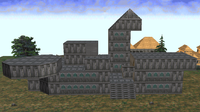
At some point later, the Orcs again lost control of Orsinium. The land was then won back by the Orc hero Gortwog gro-Nagorm of the Minat tribe in 3E 399, who was disputing claim on the land, made by the Breton noble Lord Bowyn. Gortwog won the land by defeating Lord Bowyn in a duel.[39] Named Nova Orsinium,[40] the city was rebuilt on a mountainside between Menevia and Wayrest, at the site of Torug's original Orsinium.[4][10] As the city harbored statues of Orc heroes such as Mauloch and Torug, and was built of iron, it was likely that Nova Orsinium would provoke the same reaction from its neighboring kingdoms as the first city did. However, the land prospered, as Gortwog proved to be a diplomatic as well as a political genius. Following the events of the Miracle of Peace, Gortwog used the Numidium to conquer substantial territory of central High Rock. Its application for elevation to Provincial status, which was proposed to Tiber Septim at the founding of the Third Empire, was finally beginning to be reviewed by Emperor Uriel Septim VII. Orsinium's alliance with its former foe Wayrest gave promise for a stable future and a lasting government.[10] Gortwog sent out many adventurers to explore the dungeons of Tamriel in search of treasure, to prove the wealth of the Orcs.[41]
Fourth Era[edit]
In the early Fourth Era, following the Oblivion Crisis and the destabilization of the Third Empire, Orsinium was once again sacked by the combined forces of Hammerfell and High Rock, and many Orc refugees fled east into Skyrim.[42] The kingdom eventually reformed at a new location between Skyrim and Hammerfell,[5] where it was guarded by the Seventh and Fifteenth Legions.[42]
Known Rulers[edit]
- Torug gro-Igron (the tenth century of the First Era)
- Golkarr (until ca.1E 980)
- Kurog gro-Orsinium (sometime after 2E 566 - 2E 582)
- Bazrag gro-Fharun (2E 582)
- Gortwog gro-Nagorm (the fifth century of the Third Era)
Additionally, the Orcish figure Nargi gro-Barok was known by the title of High King (usually reserved only for rulers of Orsinium) and was described as a conquering Orc king, but it is unspecified if he had any connection to Orsinium or when his reign occurred.
See Also[edit]
- For game-specific information, see the Daggerfall article. Also see the Daggerfall article on the Orsinium Area.
Books[edit]
- How Orsinium Passed to the Orcs by Menyna Gsost — The story of how Gortwog won the land to the north of Wayrest
- Lord of Souls by Greg Keyes
- Pocket Guide to the Empire, 1st Edition: The Wild Regions by the Imperial Geographical Society
- Pocket Guide to the Empire, 3rd Edition: Orsinium by the Imperial Geographical Society
- The Fury of King Ranser by Wafimeles Masteret (Lorekeeper) — How Ranser's War led to the formation of the Daggerfall Covenant
- Guide to the Daggerfall Covenant — A history and overview of the Daggerfall Covenant
- Return to Orsinium by Immigration-Wife Uulitag gra-Orsinium — A rallying pamphlet urging Orcs to return to Orsinium
- The Great Siege of Orsinium — On the famous First Era conflict between Orcs and their neighbors in the Iliac Bay
Gallery[edit]
References[edit]
- ^ a b c d e f g Pocket Guide to the Empire, 1st Edition: The Wild Regions — Imperial Geographical Society, 2E 864
- ^ Return to Orsinium — Immigration-Wife Uulitag gra-Orsinium
- ^ a b c d e f g Events of ESO
- ^ a b Events of Daggerfall
- ^ a b c Loading screen in Skyrim
- ^ Scarp Keep Loading screen
- ^ a b c d e Wayrest, Jewel of the Bay — Sathyr Longleat
- ^ a b c Bangkorai, Shield of High Rock — King Eamond
- ^ The True Nature of Orcs
- ^ a b c d e Pocket Guide to the Empire, 3rd Edition: Orsinium — Imperial Geographical Society, 3E 432
- ^ Orsinium Cracked Iron Bell antiquities codex in ESO
- ^ The Great Siege of Orsinium
- ^ Hammer of Glass
- ^ Scholar Cogline's dialogue in ESO
- ^ Thulgeg's March — Kraltha the Rememberer
- ^ The Great Siege of Orsinium
- ^ The Mirror — Berdier Wreans
- ^ Ancestral Breton Style antiquity entries in ESO
- ^ a b The Royal House of King Eamond — Seneschal Derric Andras of Castle Evermore
- ^ The War of Betony — Vulper Newgate, 3E 404
- ^ The Pig Children — Tyston Bane
- ^ Guthrag's Mask
- ^ From The Memory Stone of Makela Leki — Makela Leki
- ^ a b Loading Screen in ESO
- ^ Ramati at-Gar's dialogue in ESO
- ^ Tusks of the Orc-Father codex entries in ESO: Greymoor
- ^ Loremaster's Archive - Infinite Archive — Master Malkhest
- ^ Once — Beredalmo the Signifier
- ^ Rislav The Righteous — Sinjin
- ^ Poison Song I — Bristin Xel
- ^ Crafting Motif 8: Orc Style — Doctor Alfidia Lupus
- ^ High King Emeric Answers Your Questions — High King Emeric
- ^ a b The Fury of King Ranser — Wafimeles Masteret (Lorekeeper)
- ^ a b Guide to the Daggerfall Covenant
- ^ a b Orcs of Skyrim — Thora Far-Wanderer
- ^ The Chronicles of King Kurog — Zephrine Frey, Chronicler of Wayrest
- ^ Mort the Merry's dialogue
- ^ Summit Lord's Silken Robes costume description in ESO
- ^ How Orsinium Passed to the Orcs — Menyna Gsost
- ^ Lives of the Emperors — Niso
- ^ Events of Oblivion
- ^ a b Lord of Souls — Greg Keyes
|
||||||||||||||||||||
|
|||||
